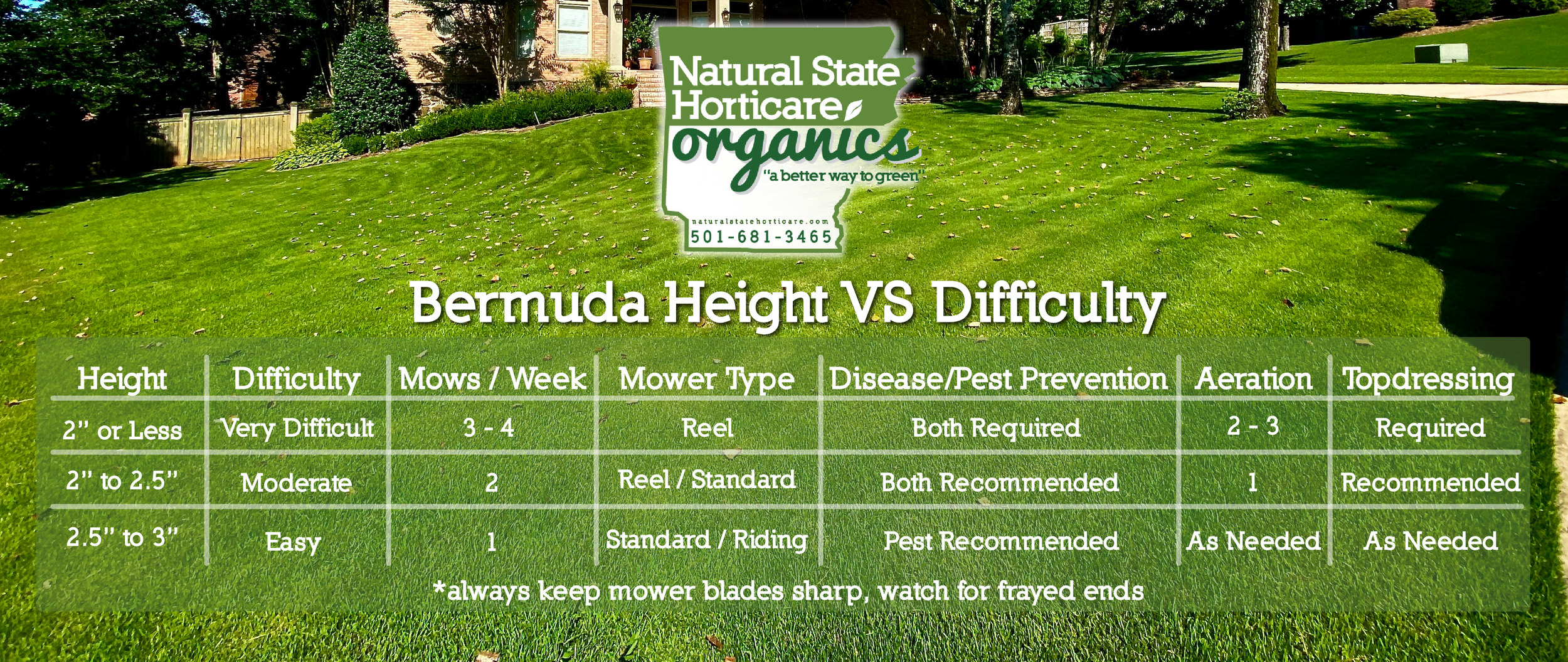Bermudagrass
The Complete Guide to Caring for Bermudagrass in Central Arkansas
Bermudagrass is one of the most widely used lawn grasses in Central Arkansas—and for good reason. It’s known for its high heat tolerance, drought resistance, quick recovery from damage, and ability to handle heavy foot traffic. While Bermudagrass thrives in the hot summers of Arkansas, it also faces unique challenges in the "transition zone" where winters can bring freezing temperatures and dormancy.
In this comprehensive guide, we’ll cover everything you need to know about maintaining a beautiful Bermudagrass lawn in Central Arkansas, including proper mowing, watering, fertilizing, managing pests and diseases, and transitioning through the seasons.
Pros and Cons of Bermudagrass
Central Arkansas’ climate presents unique challenges for lawn care. Summers are hot and humid, while winters can bring periods of freezing temperatures. This makes lawn care more complex than in other regions.
Pros
✔ Loves heat and sun
✔ Excellent drought tolerance once established
✔ Quickly recovers from damage
✔ Tolerates heavy foot traffic
Cons
🚫 Poor shade tolerance
🚫 Requires frequent mowing and maintenance
🚫 Doesn't choke out weeds like Zoysia and St. Augustine
🚫 Can spread into flower beds and nearby areas
Bermudagrass Varieties for Central Arkansas
✅ Tifway 419 (recommended)
Fine texture with a dark green color
Dense growth pattern
Great for sports fields and high-traffic areas
Quick recovery from wear and damage
✅ Celebration Bermudagrass
Deep green color
High drought and heat tolerance
Handles moderate shade better than other Bermuda varieties
Resistant to common diseases and pests
✅ TifTuf Bermudagrass
Excellent drought tolerance
Retains color longer into the fall
Strong disease resistance
Requires less water than other Bermuda varieties
✅ Common Bermudagrass
Light green color with a coarser texture
Extremely hardy and drought-resistant
Spreads aggressively
Ideal for large areas or rough, low-maintenance landscapes
Mowing Advice
Bermudagrass grows quickly and requires frequent mowing to maintain a healthy, even appearance.
Recommended Mowing Height:
2 – 3 inches for most Bermuda varieties
See the charts below to find the right height for you.
Mow higher (up to 3 inches) in shaded areas
Frequency:
Once per week during the growing season (May to September)
Increase to twice per week during peak growth (mid-summer)
The more frequent the better.
Mowing frequency is extremely important for berumdagrass
Every 2–3 weeks in early spring and late fall when growth slows
Best Practices:
✅ Keep mower blades sharp to avoid damaging the grass blades.
✅ Mow when the grass is dry to prevent tearing and disease spread.
✅ Avoid cutting more than ⅓ of the blade at a time—scalping Bermuda can stress the grass and make it more susceptible to weeds and disease.
💡 Tip: Use a reel mower rather than a rotary mower for the cleanest cut, especially when attempting to maintain turf lower than 2 inches.
Watering Advice
Bermudagrass has excellent drought tolerance due to its deep root system—but it still needs regular watering to stay green and healthy.
How Much Water:
1 to 1.5 inches per week during the growing season
Increase to 2 inches per week during extreme heat or drought
Infrequent, deep watering (3–4 times per week) is better than shallow daily watering
Best Time to Water:
Water early in the morning (between 4 a.m. and 10 a.m.)
Avoid watering in the evening to prevent fungal growth
Signs of Under-watering:
🚨 Wilting or folded blades
🚨 Bluish-gray color
🚨 Footprints remain visible after walking on the grass
Signs of Overwatering:
🚨 Mushy or spongy ground
🚨 Yellowing grass
🚨 Increased weed or fungus growth
💡 Tip: Bermuda will go dormant in extended droughts but will bounce back quickly once watered consistently.
Shade Tolerance of Bermudagrass
Bermudagrass thrives in full sun and struggles in shade. Click here to learn more about shade issues.
Minimum Sunlight Requirements:
Needs 6–8 hours of direct sunlight daily
Grows poorly in areas with tree cover or next to buildings and fences.
How to Improve Shade Tolerance:
✔ Increase mowing height in shaded areas to maximize leaf surface.
✔ Remove trees
✔ Thin tree canopies
✔ Raise tree canopies
Disease & Pest Control
Bermudagrass is tough, but it's still vulnerable to certain pests and diseases, especially during hot, humid weather. Click here to learn more about common lawn pests.
Common Pests:
Armyworms – Sudden thinning and browning of grass
Grubs – Root damage, causing wilting and spongy turf
Common Diseases:
Dollar Spot – Small, round brown spots
Spring Dead Spot – Patches of dead grass that don’t recover in spring
💡 Tip: Proper mowing and watering reduce pest and disease risk. Treat infestations quickly with targeted insecticides or fungicides.
Winter Dormancy and Cold Tolerance
Bermudagrass will go dormant and turn brown when temperatures drop below 50°F.
Winter Care:
✅ Keep the grass mowed to 2 inches before dormancy.
✅ Remove leaves and debris to prevent fungal growth.
✅ Avoid foot traffic on dormant grass to prevent damage.


